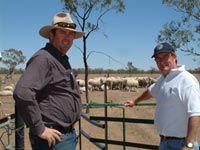
Sheep farmers urged to rethink flock management

Bourke grazier Tony Thompson and NSW DPI
e-sheep researcher Bill Murray inspect the
remote walk-through weighing yard.
Commercial sheep farmers have been urged to rethink how they manage wool and meat production in their flocks.
NSW DPI Principal Research Scientist, Dr Kevin Atkins, told the Australian Sheep Industry Cooperative Research Centre (Sheep CRC) conference in Orange in February that the ‘modern face’ of sheep farming was individual animal management.
Dr Atkins said growers could be more productive and improve profits if they focused on measuring and managing flocks for individual traits.
“Sheep production systems have developed as low labour input enterprises and in general, ram purchases have been the biggest influence on the genetic composition of the flock.
“Sheep have usually been managed in groups and productivity growth has been linked to reducing costs.”
Dr Atkins and his colleagues have undertaken research showing that “if growers collected more information about individual animals and applied it to selection and management within commercial flocks, substantial benefits in productivity and profitability can be achieved both now and into the future.”
Previously measurement and selection in commercial flocks was rarely recommended because of the cost and perceived limited genetic impact within a flock. However, he said a number of recent advances had reduced costs.
These include:
- Automated measurement options such as on-farm fibre measurement,
- New measurement tools, such as walk-through weighing,
- Radio frequency identification (RFID), integrated with measurement systems, which allows for much more efficient data capture, data storage and information recall, and
- The capacity to make selection decisions in real time that either eliminate the need for permanent identification and/or allow further data to be added to historical information so that decisions can be made on the spot.
Dr Atkins said there was now no need for re-mustering simply to apply a decision.
“Software solutions exist which enable data to be analysed at the time that it is collected and these have been proven to work when applied to sheep systems.
“Where auto-drafting is used, the selection decisions can be applied in real time.”
Dr Atkins said progress had also been made in relation to genetic gain.
“While it is true that genetic gain from ewe selection is limited, other pathways to improving the flock using measurement need to be considered”, he said.
These include the fact that:
- Current generation gains, from a single mating, can be very large.
- Targeting multiple markets by selecting groups of animals on their fitness for high value markets, or reducing costs in meeting lower value targets, are real options for animals within a flock.
- Precision management applied to selected sub-flocks can be used to exploit variation in value or response of sub-groups of animals within the flock.
Dr Atkins said once measurements were done it was time to consider how your flock is managed in relation to the cumulative gains that can be achieved from applying this new information.
“There are many entry points for producers to engage in precision selection and management.
“It may simply be using real time information to aid decisions or you may opt for a high end solution involving complex recording and drafting systems.”
Further information
Research into individual animal management is a project of NSW DPI and the Sheep CRC. More details are available from the Sheep CRC website.
Kevin Atkins, NSW DPI, Orange on 02 6391 3816 or kevin.atkins@dpi.nsw.gov.au.
Email:

